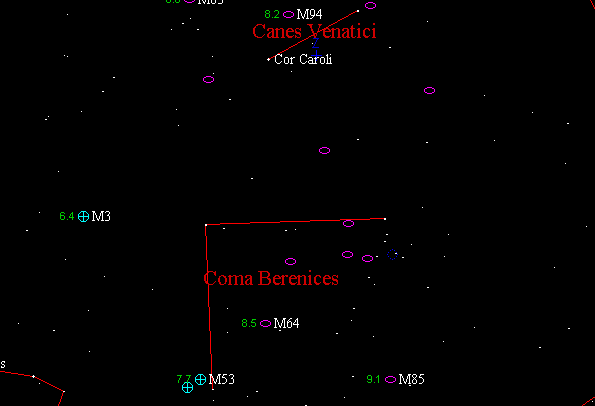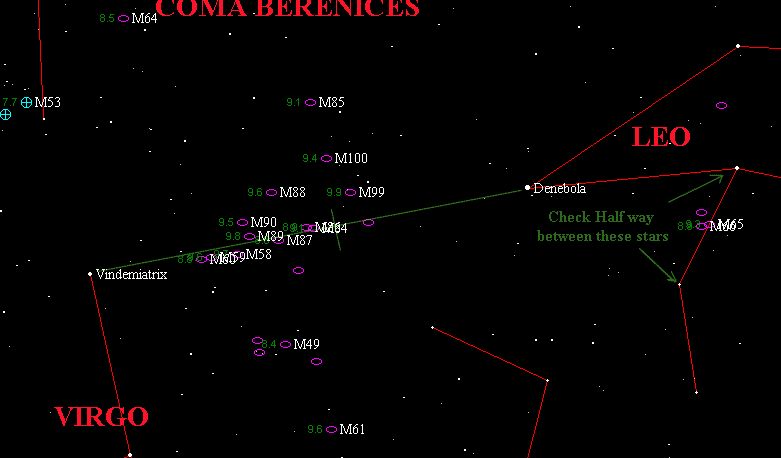

 |
 |
| Searching the Dipper and Points South - Spring |

Photo by Doug Clapp, Thanks to Nova Astronomics
To start our exploration we will search for M51, also called the Whirlpool Galaxy. Locate the last star in the handle of the Big Dipper (Alkaid). Then locate the two brightest stars in Canes Venatici and imagine a line between Alkaid and the eastern most star of Canes Venatici two stars. M51 will be one quarter the way from Alkaid.
Just above Alkaid, to the north, is M101. To find M101 locate the next star from Alkaid in the handle (Mizar). Now imagine that Alkaid and Mizar form the bottom of a triangle and the imaginary point that forms the top of the triangle is where M101 is. M101 according to the charts is brighter than M51, but M101 is spread out and covers a larger area of sky. When they tell you how bright an object is on a chart they figure how bright it would be if you condensed it to a point like a star and then assign its magnitude brightness (I don't know why they do it that way). So M101 really is dimmer and a lot harder to see than M51.
In finding M109, you first locate the bottom of the Dippers bowl then locate the star on the bottom of the bowl that is closest to the handle. The two bottom bowl stars form a line, continue that line just past locate the star on the bottom of the bowl that is closest to the handle. There you should see M109.
On the same line but toward the star furthest from the handle (Merak) you can find M108 about one fifth of the way from Merak along the bottom of the bowl.
Now using the locator star we used to find M109 and the star catty corner in the Dipper bowl Dubhe as a pointer. follow that imaginary line the same distance away from Dubhe as the distance between the two pointer stars (see above graphic showing arrow). This should get you in the area where M81 and M82 are. These are two galaxies that are interacting with each other.
Remember the eastern most star in Canes Venatici we used to find M51, and the locate the star on the bottom of the bowl that is closest to the handle used to locate M109. Draw an imaginary line between them and look halfway between them for M106.
So far we have seen only galaxies but at the star where the handle connects to the bowl, slightly to the northwest lies M40 and according to one my charts it is a faint star cluster, according to another it is a double star. Locate it and find out.

The landmarks for finding the above deep space objects were from a well-recognized asterisms (asterisms are groups of stars that are not official constellations but commonly recognized such as the Big and Little Dipper). Now there are even fewer landmarks to use and it gets harder to describe how to find them. Remember to go on an exploration like this you will need dark clear skies, a telescope of at least 4 inches (8 to 10in. to see them all - the bigger the better), star charts, and a good eye.
To start our exploration we will search for M63. Locate the last star in the handle of the Big Dipper (Alkaid). Then locate the two brightest stars in Canes Venatici and imagine a line between Alkaid and the western most star of Canes Venatici two stars. M63 will be three quarters the way from Alkaid. This is pretty much the same as the search for M51.
If you drew a line from Alkaid in the Big Dipper to a point in the middle of the two stars in Canes Venatici, then from that point you went toward Alkaid about the half distance the two stars in Canes Venatici are you should be able to find M94. That finishes the area in the Big Dipper to Canes Venatici.
To the south of Canes Venatici is the constellation Coma Berenice. Coma Berenice is home for M64, M53, and M3. M3 and M53 are globular clusters and M64 is another galaxy. The two brightest stars in Coma Berenice run close to east and west. If you continue the line to the west for about three fourths of the distance those two star are apart and scan to the north of that spot (told you it gets harder) you should see M3. Now if you search straight south of the western most of those two stars at a distance about the same, as they are apart, you should be able to find M53. To describe how to find M64 you will had to have succeeded in finding M53. From M53 to the eastern most bright star in Coma Berenice and about one third of the way there is M64.

Galaxies tend to clump together in-groups. Our galaxy, The Milky Way is one of the two major members in our group with the Andromeda Galaxy being the other larger major member. Our group is called the local group. If we look out in space just north of the constellation Virgo, we can find the Virgo Cluster. I'm not going to tell you how to find each member I'll just point you to the heart of it and you can scan, and explore on your own. Looking at the constellation Leo, we can see the back part form an easy to see triangle. That triangle points to a bright star in Virgo called Vindemiatrix. If you draw a line between the two and go about three-fourths the way toward Vindemiatrix you will be in the midst of a very large group of galaxies. Spend your time and explore this region well and you will be very well rewarded with many splendid sights.
Remember you will never see deep space objects as sharp and colorfull as the photographs of them. What you do see as far as detail will depend upon the diameter of your objective, how dark your skies are and the skills you have developed in observing faint objects.